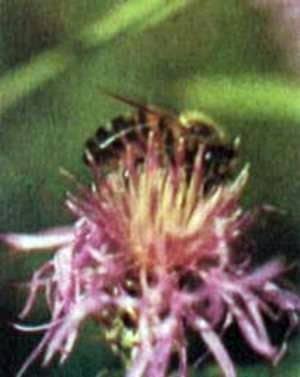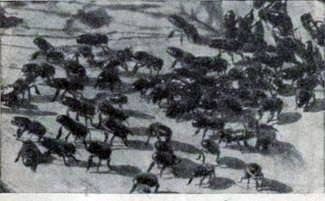
To what extent, with the correct choice of color, the bees use this identification sign of their hive for orientation, can be solved not by reasoning, but only by experiments.

Fig. 63. Use of bee hive colors for orientation.
A – the usual order of the arrangement of the hives, to which bees are accustomed. Hive No. 4 is inhabited and covered with a blue shield, No. 5 is empty and covered with a yellow shield, No. 2 and 3 are not covered with shields (they have a white color) and are also empty.
Tin boards on the reverse side are painted: blue – in yellow, and yellow – in blue;
B – turning the shield on the hive No. 4, its coloring is turned into yellow, the shield with the hive number 5, also turning and turning into blue, is outweighed to the hive No. 3. All the returning bees fly to the uninhabited, now blue hive No. 3.
For this purpose, a large pavilion approaches, the hives of which are completely identical in appearance. On one side of this pavilion we will put several empty hives alongside. On the front wall of one of them we hang a large blue shield of tinplate and the same tin plate of blue color put on the board. The right adjoining hive No. 5 will be equipped in the same way with a yellow facing, and the neighboring hive on the left will be left unchanged, that is, as white as all the other beehives of this pavilion.
Now we will settle in a blue hive a family of bees and wait a few days. Blue, yellow and white bee-eyes distinguish well. If the departing bees do use the blue color proposed for them to recognize their hive, we can expect that by changing the tin plates in places, we will force the bees to fly into someone else’s home.
However, the following precaution is necessary. On the blue tin plate of the inhabited hive, especially on a small tin plate on the board, in those days an innumerable bees were leaving the hive and returning to it. Tin sheets have got the smell of bees, which a person can clearly detect.
If we outweighed the blue sheets of tin to the neighboring hive and the bees would then fly into an empty blue hive, it would be impossible to find out whether they are guided by the blue color of the hive or the smell. Therefore, the reverse side of the blue sheets of tin was painted yellow, and the reverse side of the yellow sheets – in blue. Now, in order to change the color of the hive, you do not need to change the sheets in places, but simply turn them by the other side.
Since the approaching bees pay attention to the neighboring hives, so that the position of the blue hive in relation to the coloring of the neighboring hives does not change, on the inhabited hive No. 4 turn the sheets of tin with the other side and turn it from blue to yellow. Tin sheets from the right neighboring hive will be taken off, and, having turned them, we will outweigh to the left neighboring hive, which due to this will turn blue. Thus, the order of the arrangement of the painted hives with respect to the white hive, to which the bees are accustomed, will remain: to the left of the blue hive there will be white, and to the right – yellow.
The result of the change in color is striking: the whole stream of returning bees, which in a short time, which was required to outweigh tin sheets, accumulated in front of the pavilion, without hesitation for a second, is sent to an empty hive. There is no doubt that bees are misled by its blue coloration. This lasts a few minutes. All the departing bees come out of the yellow hive, and those who return home fly into an empty blue hive. From this experience, the decisive importance of coloring hives for the orientation of bees on the apiary is clearly evident.
What experience teaches us is confirmed by everyday practice. If the beehives in the apiary are painted in such colors that the eyes of the bees are well discerned, the bees are mistaken much less often. It is enough to mark several hundreds of bees from one beehive with colored dots to make sure that for many days and even weeks they return only to their hive.
It is easier to find your hive and uterus when returning from a mating or from an approximate flying. On the large, exemplary apiary of the upper Bavarian monastery of St. Ottilia since 1920, a book of registration of all queens has been conscientiously conducted. In 1920 and 1921 the hives were not painted in different colors. During these 2 years, 16 young queens of 21 were lost. In the next 5 years after all the hives were painted with due regard for the peculiarities of the color vision of the bees, only 3 of the 42 young mothers disappeared.
So, the beekeeper must take into account the following: bees clearly distinguish between blue, yellow, black and white colors, and therefore should be limited to them when painting hives. It should take care that in one row between two monochrome hives there are at least two hives, painted in other colors. Coloring the hives to the left and right of the hive of the color that has already occurred should not repeat the previous color combination, because the colors of the neighboring hives and their location relative to the native hive also serve as reference points for the bees. It is not advisable to paint only the incoming plates, it is necessary to paint the entire front wall of the hive. This facilitates the bees orientation when returning to the dwelling as far as our knowledge allows.

Fig. 64. An example of the appropriate order of the arrangement of flowers in the coloring of hives, which facilitates the bees looking for their home. Instead of black, you can choose a bright red, which the bees seem black. (The blue hives are shaded in the cage, the yellow hives are indicated by horizontal lines.)
You can slightly expand the set of paints that are acceptable for coloring hives, using lead and zinc white. Both of these “white” colors for our eyes are the same. But if the lead whites very strongly reflect the ultraviolet rays invisible to us, then the zinc white absorbs them. As a result, lead white should also appear to bees “white”; because they evenly reflect all the beams of light visible to the bees. Zinc white (as well as white flowers) should seem to the bees a bluish-green. Indeed, experiments have shown that both of these colors differ from each other. We do not recommend the use of other white dyes, since they do not completely absorb and do not completely reflect the ultraviolet rays.
What color they seem to bees, it is difficult to solve. Failures of many beekeepers when staining hives in white are caused, perhaps, by the use of paints, the assessment of perception by bees is still unclear. Probably, some paint will be found later, which is perceived by bees as ultra violet. This issue requires further study and practical verification.
Color – not the only means of orienting bees. If the hives are not colored, the bees are guided by the distance from their home to the nearest corner of the pavilion or by other visual signs. But above all they are guided by the smell of their own family.
Of great importance is also the smell, spreading from the odorous organ of the worker’s bee. The bees surprisingly use this organ in their beehive as soon as the need to notice the dwelling becomes particularly important, for example, in the first warm days of early spring, when the idea of the position of the native hive during a long winter rest has already lost its time or after the swarm has settled into a new dwelling. In this case, the bees stand in the door and on the landing board, turning to the side of the head and lifting up the abdomen. They protrude the odoriferous gland and, vibrating with wings, direct the smell spreading from it towards the incoming comrades.

Fig. 65. “Wearing tails” bees. Sitting near the tap, bees indicate the place where they visited, with the help of the smell emitted by their fragrant glands. Waving their wings, they create an air stream that chases the smell to meet friends returning home.
“Bees wag their tails,” say German beekeepers. The smell, published at the same time, is the same for different families, therefore, it seems to warn “there are bees here”, and not “here is your family.” Undoubtedly, in the natural conditions of settling bees in hollows of tall trees, the bee smell was more necessary to bees than on our apiaries, where families are unnaturally concentrated in one place, like apartments in the houses of a big city. Thus, without taking into account the visual reference points, bees can be convinced, although for a weaker, but familiar smell of their hive, that they are at the gate of their home. This hive odor, depending on the types of nectar brought to it, pollen and many other components that have not yet been studied, has its own special character,
Кочевой домик. Сбор пчелами нектара и пыльцы.
Biology of the bee family